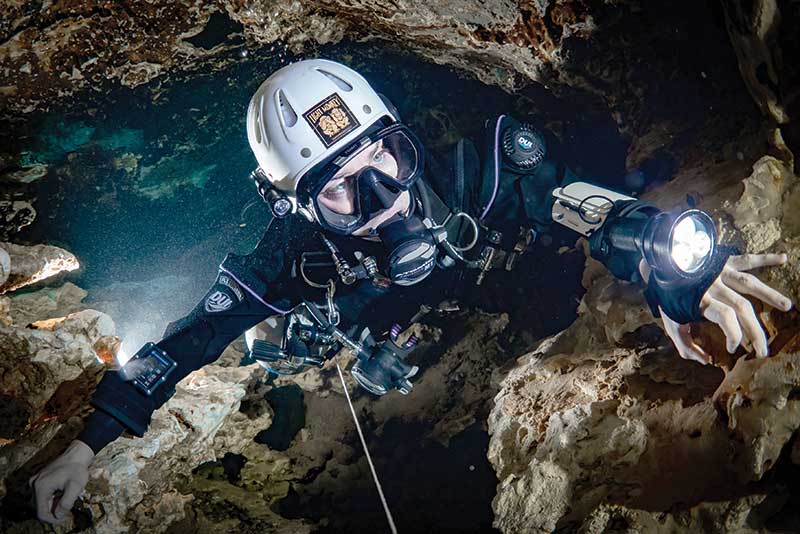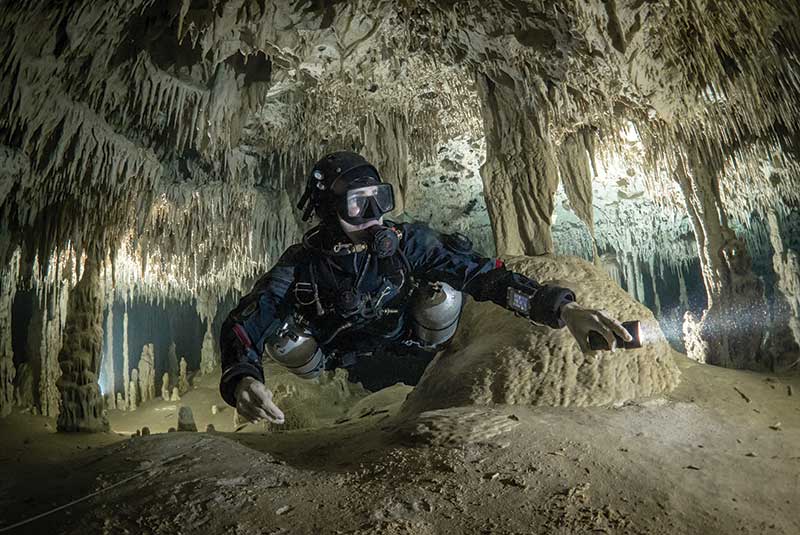Cave Diving Lights: Canister vs Handheld
By Natalie Gibb

Fourteen years ago, the cave diving scene in Mexico looked a lot different than it does today: large, gruff men lounged on the tailgates of their pickup trucks, balancing backmount double tanks against the walls of their truck beds while they regaled each other with tales of badassery. Strapped to their harnesses were unwieldy boxes holding the power source for their cave lights. In many cases these boxes contained actual motorcycle batteries that added pounds to their rig’s weight and provided power to what contemporary cave divers would consider comically weak primary lights.
The more technologically advanced divers—those with a little extra cash—had swapped out their motorcycle batteries for cutting-edge canister lights: slick, cylindrical metal or delrin tubes that were much more streamlined and contained stronger, more powerful nickel-metal-hydride batteries, as opposed to lead-acid ones. The canisters were still large and a fully-charged battery pack typically only ran an HID light for a few hours, but the technology was a leap forward for cave divers.
By the time I could afford a primary light, the market had improved a bit and I purchased one these cutting-edge lights, a Dive Rite 1000-lumen LED with a NiMH battery back that gave me maybe three hours of burn time. It was small enough for a tiny woman, but the power came nowhere near the strong beams of the more delicate HID bulbs that most divers were using. Being accident prone, I preferred the durability of an LED, and the light served me well. However, since those days, light technology has exponentially improved, and now even my small, $160 USD backup light has a longer burn time and a brighter beam than my first primary light.
Two major advancements in dive light technology are lithium ion batteries and powerful LEDs. Each year, it seems that light manufacturers premiere stronger lights with longer burn times. Light technology is improving so rapidly, that even my primaries from a few years ago feel weak and obsolete.
One of the main changes made possible by new technology is the elimination of the primary light battery canisters. Now, handheld lights rival both the power and burn time of previous generations of canister lights, while many new canister lights boast burn times of up to eight hours—on full power! With so many amazing options, the first and perhaps more fundamental decision when purchasing a primary light is whether to take the leap to handheld or stay with the tried-and-true canister style. Here’s a breakdown of the pros and cons of each.
Lack of canister
The lack of a battery canister has some pros and cons. For small divers like myself, eliminating any bulk from your rig is a benefit. In backmount, I have more space on my waist, and in sidemount I don’t have to deal with the canister off-balancing my trim.
For backmounters who are accustomed to routing their long hose under a hip-mounted light canister, the lack of canister can create issues for hose management, although ‘blank’ canisters and hose holders are available for this purpose. For divers who use heated vests, which may require an additional canister battery, eliminating one of two battery canisters may be a benefit.
Bulk of the light head
Canister lights have smaller, lighter, and more maneuverable lights heads, as the power is supplied via the cable from the canister. Handheld lights require that the power source be contained in a single sealed unit along with the light head itself, which leads to a bulkier handheld light. For most handheld lights, weight is not a concern, as the larger size of the light offsets the weight with its increased buoyancy. However, length and size of the light are definitely considerations.

Elimination of the light cable
Canister lights supply power to the light head from the canister via a sealed cable. In both backmount and sidemount configurations, the routing of the light cable is a consideration. Practice and protocols are needed to avoid entangling a diver’s long hose in the light cable during air-shares or long hose deployment, and eliminating the cable simplifies these procedures.
Cables are also a failure point, and this is the main reason I prefer handheld lights. Nearly every primary light failure I have had originated with the light cable. Technical diving promotes the elimination of potential failure points, and light cables create several; including the seal where the cable enters the canister, where it connects to the light head, and the potential to kink or damage the cable itself.
There is one major drawback to eliminating the light cable: the possibility of dropping the light! Technical divers should be able hold a light in either hand during a dive. For example, it’s essential to be able to hold your light temporarily in your right hand while checking a pressure gauge on your left side, but it’s also important to hold your light in your left hand when donating a long hose to an out-of-air diver with your right hand. This means that a light head cannot be permanently attached to the diver’s hand during the dive. Without a cable or permanent attachment, a diver risks accidentally dropping his primary light.
Burn time and brightness
As battery technology has improved, so have the burn times and power of primary lights. Even smaller, handheld primaries are extremely bright and have decent burn times. That said, if you want maximum power and extremely long burn times, clearly the possibility of carrying a larger battery pack in a canister can lead to even brighter and longer-lasting lights.
Flying your light
For a traveling technical diver, the ability to open most handheld primary lights and remove the batteries for airport security reduces stress and possible confusion with airport personnel. Similarly, the small size of handheld lights makes them easy to transport. Handheld lights with the batteries removed may be checked while the batteries are carried on, reducing the amount of carry-on luggage for travelers. However, the small size and weight of handheld light makes them easy to carry on as well!
The decision to purchase a primary light is a big one, and I would recommend demo’ing the light you are considering before purchase. If you can, do some dives with both canister and handheld lights before you make your choice, and get some experience with each style in order to make an informed decision.
My personal preference is for handheld lights, based on the reduction of failure points, the ease of battery replacements, and elimination of the light cable and canister. However, I have dropped a handheld light at the bottom of a sinkhole and had to make a trimix dive to recover it. Factor in your clumsiness factor and dexterity when making your final choice!
Natalie Gibb Is a full cave instructor, explorer, and researcher based in Mexico’s Riviera Maya. She is a published author, international speaker, and cave conservationist. For more visit: www.underthejungle.com
One Response to “Cave Diving Lights: Canister vs Handheld”
Leave a Comment








Richard Mooney
I’m an aspiring cave diver and a wreck diver. I carry a helmet with removable video lights (2) and carry a light and motion handheld on a Goodman handle with an elastic bungee runaway wrist loop. I also carry a compact shoulder mounted back-up light with a laser pointer.
ISE (inner Space Explorers) has a rather nifty three light combination “Alien Light” on a single Goodman handle. Idea is to have three light redundancy.
Curious about what handheld options you might recommend.
-Rick M